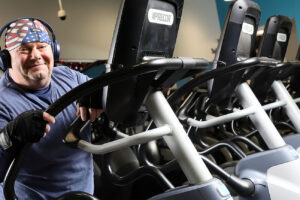Imagine always feeling the pain and urgency of a full bladder, even when you just went. That was Frankie Perna’s life for three decades until she learned the cause of the condition – and how to overcome it.
Since her late 20s, Frankie, now 61, has had trouble fully emptying her bladder. The Red Bank resident was in chronic pain. Tests, medications, and treatments over the years failed to diagnose or treat the issue accurately.
“I just learned to live with constant pain,” Frankie says. “I always had to stay close to a bathroom. It affected my quality of life.”
Frankie was referred to CentraState family medicine physician Jaclyn Guliano, MD, in 2021. After an assessment and physical exam, Dr. Guliano diagnosed Frankie with chronic interstitial cystitis, also known as painful bladder syndrome.
In interstitial cystitis, the pelvic nerves tell the brain the bladder is full even when it isn’t. As a result, sufferers need to urinate more often and with less urine than most people.
Focusing on the Pelvic Floor
To treat the condition, Dr. Guliano referred Frankie to CentraState’s Pelvic Floor Physical Therapy Program. The pelvic floor is a group of muscles at the base of the pelvis, near the bladder. Frankie first had a one-on-one evaluation with a physical therapist at CentraState Health Pavilion at Marlboro.
“I learned that while some people harbor stress in the neck or back, I harbor mine in my pelvic floor, which affects my bladder,” Frankie explains.
Pelvic floor therapy can incorporate a variety of interventions, including:
- Therapeutic exercises
- Manual therapies
- Biofeedback techniques paired with ultrasound to help retrain the muscles
- Relaxation, stretching, yoga, and breathing techniques
- Pain management strategies
- Other specialized techniques to relieve tension, facilitate soft tissue healing, and reduce pain and inflammation
“We evaluate the whole person and develop an individualized plan for each patient,” says physical therapist Danielle Gorman-Robbins, PT, DPT, CLT. Frankie’s therapy included breathing techniques, stretching exercises, yoga poses, and massages. A few weeks after working with Danielle, the pain subsided and Frankie could venture out without anxiety. “Physical therapy worked miracles,” says Frankie. “This is an uncomfortable topic for some people to talk about, but so many suffer when they don’t have to.” Now, she’s back at the gym and even incorporates pelvic floor exercises into her workouts. She also enjoys going on road trips again and walking the 15-mile trail near her home. “Having pelvic pain is common, but that doesn’t mean it’s normal,” Danielle advises. “Don’t be afraid to ask your doctor questions. If something doesn’t feel right, get help so you can live a better life.”
For more information about pelvic floor therapy at CentraState, visit centrastate.com/pelvicfloor or call 866-CENTRA7 (866-236-8727).





